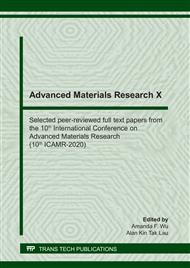[1]
Standard Method of Test for Resistance of Concrete to Chloride Ion Penetration", (T259-80), American Association of State Highway and Transportation Officials, Washington, D.C., U.S.A.,(1980).
Google Scholar
[2]
Standard Test Method for Electrical Indication of Chloride's Ability to Resist Chloride" (ASTMC1202-94) 1994 Annual Book of ASTM Standards V 04.02, ASTM, Philadelphia, pg. 620-5.
Google Scholar
[3]
Standard Method for Sampling and Testing for Chloride Ion in Concrete and Concrete RawMaterials", (T260-94), American Association of State Highway and Transportation Officials,Washington, D.C., U.S.A, (1994).
Google Scholar
[4]
Yingwu Zhou, Hao Tian, Lili Sui, Feng Xing, and Ningxu Han: Strength Deterioration of Concrete in Sulfate Environment, An Experimental Study and Theoretical Modeling, Hindawi Publishing CorporationAdvances in Materials Science and Engineering Volume 2015, Article ID 951209, 13 pages.
DOI: 10.1155/2015/951209
Google Scholar
[5]
J.R. Clifton and J. M. Pommersheim, Sulfate Attack of CementitiousMaterials:Volumetric Relations and Expansions, Buildingand Fire Research Laboratory, National Institute of Standardsand Technology, Gaithersburg, Md, USA, (1994).
Google Scholar
[6]
C. Sun, J. Chen, J. Zhu, M. Zhang, and J. Ye, A new diffusionmodel of sulfate ions in concrete,, Construction and BuildingMaterials, vol. 39, p.39–45, (2013).
Google Scholar
[7]
Electrical Indication of Concrete's Ability to Resist Chloride", (T277-93), American Association of State Highway and Transportation Officials, Washington, D.C., U.S.A., (1983).
Google Scholar
[8]
K.D. Stanish, R.D. Hooton and M.D.A. Thomas: Testing the Chloride Penetration Resistance of Concrete: A Literature Review, 1-33, FHWA Contract DTFH61-97-R-00022"Prediction of Chloride Penetration in Concrete".
Google Scholar
[9]
A. Bonakdar, B. Mobasher, and N. Chawla, Diffusivity and micro-hardness of blended cement materials exposed to external sulfate attack,, Cement and Concrete Composites, vol. 34, no.1, p.76–85, (2012).
DOI: 10.1016/j.cemconcomp.2011.08.016
Google Scholar
[10]
A. E. Idiart, C. M. L´opez, and I. Carol, Chemo-mechanical analysis of concrete cracking and degradation due to external sulfate attack: a meso-scale model,, Cement and Concrete Composites, vol. 33, no. 3, p.411–423, (2011).
DOI: 10.1016/j.cemconcomp.2010.12.001
Google Scholar
[11]
Jun Takada : Symposium paper on salt damage repair method using chloride ion adsorbent and its effect, rehabilitation of concrete structures, pp.87-92,1998.10.
Google Scholar
[12]
Satoshi Takaya, Yuji Sudo, Takashi Yamamoto, Toyoaki Miyagawa: Mechanism of inhibition of steel corrosion by nitrite ions in concrete, Annual report on concrete engineering, Vol36, No.1, pp.1270-1275,(2014).
Google Scholar
[13]
Yasuhiro Ohno, Shuhei Sugiyama, Kunihiko Yokota, Junji Yamazaki: Water Treatment System Using NLDH / Microcrystalline Layered Double Hydroxide, Proc.
Google Scholar
[14]
Toshihiro Senga, Satoshi Yamauchi, Daiki Yokoyama: Basic properties of epoxy resin mixed with salt adsorbent, Annual report on concrete engineering, Vol37, No.1, pp.1531-1536, (2015).
Google Scholar
[15]
Toshihiro Senga, Atsushi Yamauchi, Daiki Yokoyama, Shigeyuki Date: Verification of rebar corrosion inhibition effect of epoxy resin mixed with salt adsorbent used as cracking material, Annual report on concrete engineering, vol.39, No. 1,(2017).
Google Scholar


